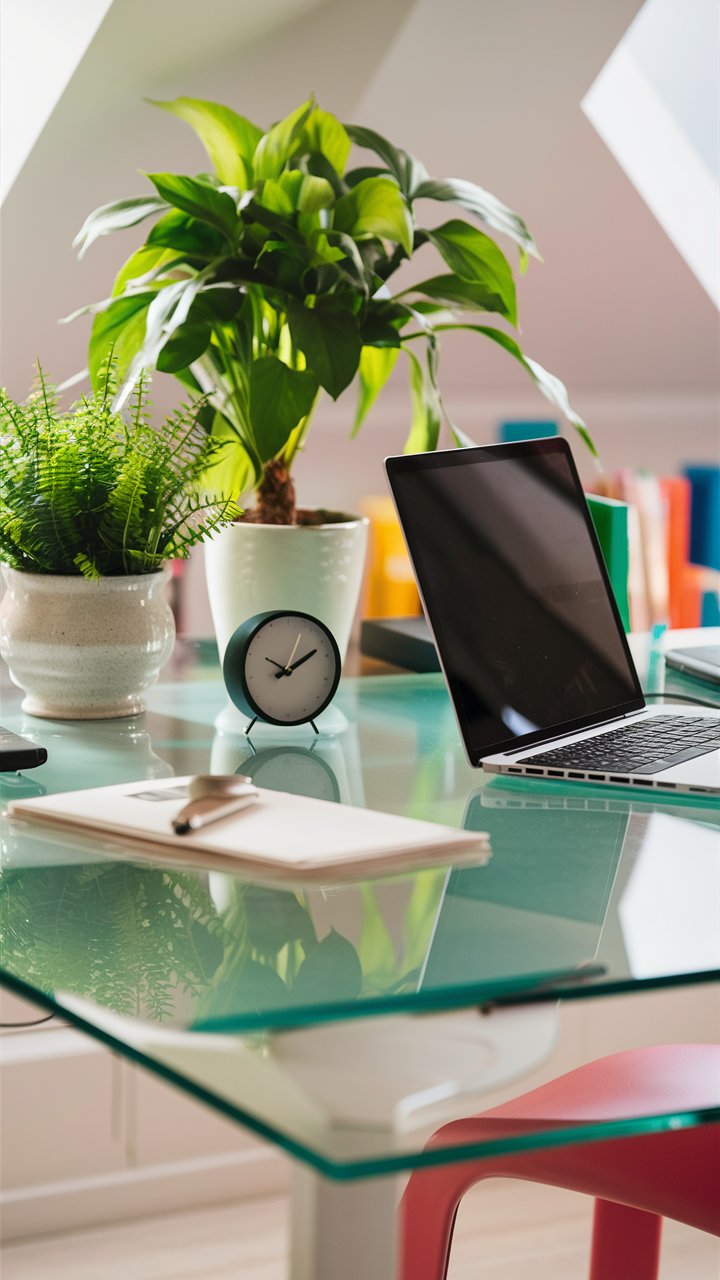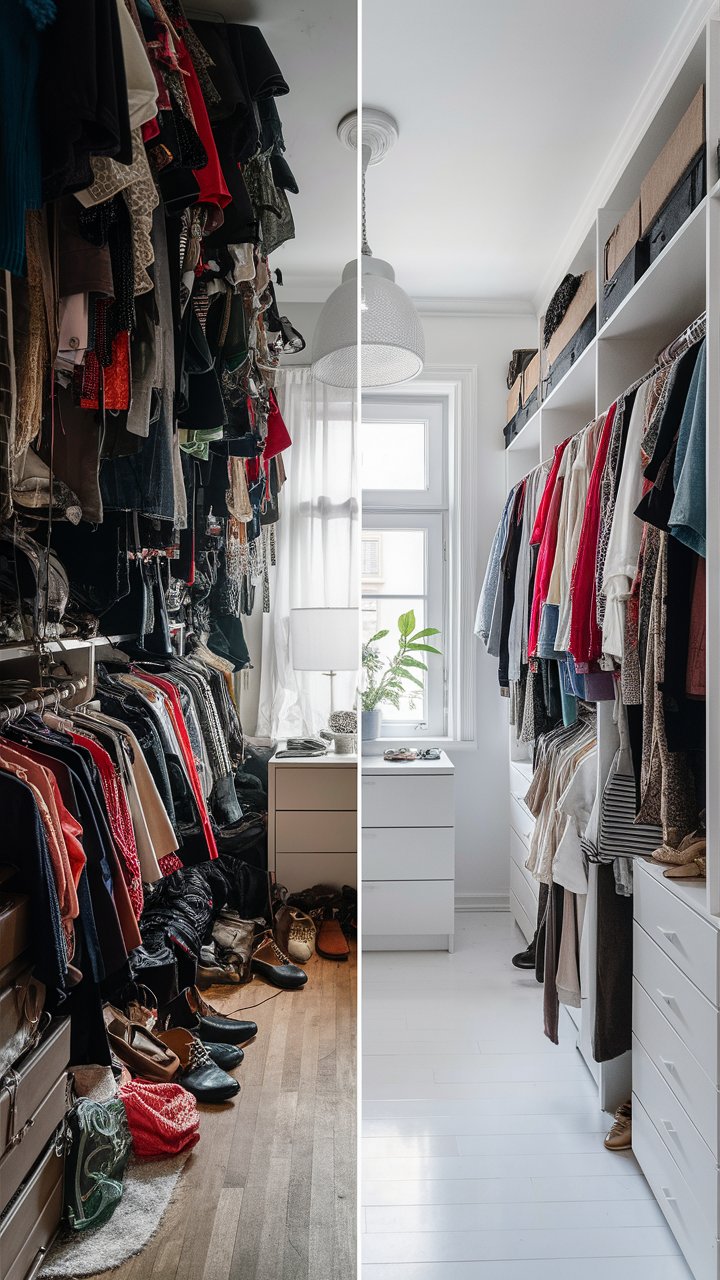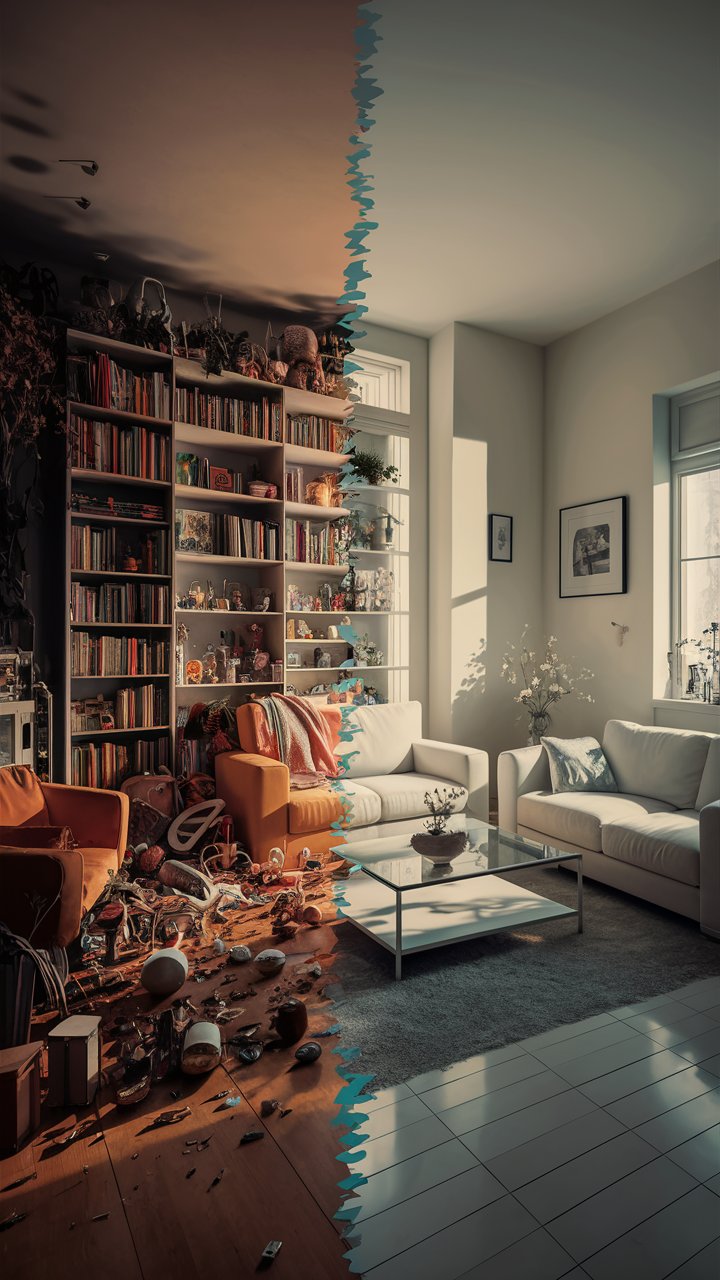Introduction
A minimalist checklist can significantly improve the space in your home by helping you let go of items you never wear and reduce clutter. This method not only enhances your living area but also alleviates stress or anxiety associated with excess possessions. By focusing on essential items and removing those that do not serve a purpose, you adopt a minimalist approach that simplifies your life and surroundings.
Starting with your closet, which might be a dumping ground for items you don’t wear, can be transformative. Use this checklist to assess what to keep and what to discard, ensuring your space remains clutter free. This systematic purging process involves decluttering items that no longer bring value, making room for what truly matters. Through this, you maintain a clean environment that supports your well-being and minimizes distractions.
Key Takeaways
- A minimalist checklist enhances your living space by helping you declutter, thus reducing stress and creating a more organized environment.
- Starting with areas like your closet to discard unused items ensures your space remains clutter-free and functional.
- Creating a decluttering checklist is essential, as it provides structure and helps in making mindful decisions about what items to keep.
- Embracing a minimalist wardrobe focuses on essential, versatile pieces, simplifying choices and maintaining a stylish, functional closet.
- Systematic decluttering across your home promotes a serene and efficient environment, allowing for better focus and reduced clutter.
- Maintaining a minimalist lifestyle involves regular review and mindful purchasing, ensuring a decluttered, stress-free living space that enhances well-being.
Understanding the Minimalist Checklist

A minimalist checklist is a comprehensive guide designed to help you declutter your home and life, identifying essential items and removing unnecessary clutter that doesn’t add value. This approach simplifies your living space and reduces stress and anxiety caused by excess belongings. By following a minimalist checklist, you can create a more organized and peaceful environment that supports your overall well-being. Embrace this change to rejuvenate your surroundings, ensuring valuable storage is utilized efficiently.
| Room | Items to Declutter | Action Steps | Notes |
|---|---|---|---|
| Kitchen | Multipurpose appliances, utensils, expired items | Keep essentials, discard duplicates, donate unneeded items | Focus on functionality over quantity |
| Living Room | Decorations, magazines, unused electronics | Retain functional items, remove clutter that doesn’t add value | Simplify decor to enhance space utility |
| Bedroom | Old clothes, worn-out shoes, excess accessories | Use capsule wardrobe approach, donate items not used in the last year | Keep the environment serene and declutter regularly |
| Bathroom | Expired products, unused toiletries | Keep essentials, dispose of expired items safely | Minimalist approach can reduce time spent on upkeep |
| Home Office | Old documents, unused cables, redundant office supplies | Digitize what you can, dispose of or donate redundant items | Streamline to enhance focus and productivity |
What is a Minimalist Checklist?
A minimalist checklist is a tool that helps you systematically declutter different areas of your life. It includes categories for various items, such as clothing, kitchen appliances, and miscellaneous items. This checklist allows you to evaluate each item’s necessity, helping you keep only what you truly need and use. It’s an effective way to simplify your possessions and create a more intentional living space.
The Importance of a Minimalist Checklist in Decluttering
Using a minimalist checklist is crucial for successful decluttering. It provides structure and guidance, making the process less overwhelming. With a checklist, you can tackle one area at a time, ensuring thorough decluttering. This method also helps you stay focused and committed to your minimalist journey, leading to a more organized and clutter-free home. Ultimately, a minimalist checklist helps you make mindful decisions about what to keep and what to let go.
Getting Started with Minimalism

Embarking on a minimalist journey can be a transformative experience. It starts with a commitment to live with less and focus on what truly matters. To get started with minimalism, you need a clear vision and a plan. This involves setting realistic goals, creating a decluttering checklist, and gradually simplifying different areas of your life. With determination and consistency, you can achieve a minimalist lifestyle that brings more peace and fulfillment.
Essential Steps to Start Your Minimalist Lifestyle
-
Set Clear Goals: Begin by clearly defining what you aim to achieve with minimalism. This could be anything from decreasing stress, clearing out your living space, or simplifying your routines.
-
Declutter Gradually: Start small, with a drawer or a shelf, and work your way up to bigger areas. Organize items into categories such as “keep,” “donate,” and “discard,” which makes the process more manageable.
-
Focus on Quality Over Quantity: Prioritize fewer but higher-quality items that genuinely add value to your life. This approach should apply to all possessions, including clothing and household items, helping reduce unnecessary accumulation.
-
Incorporate Mindful Consumption: Reflect on each potential purchase, assessing whether it brings joy or necessity to your life. This helps curb impulsive buying and encourages a more experience-focused lifestyle over accumulating material goods.
-
Regular Reflection and Adjustment: Maintain your minimalist lifestyle by regularly evaluating your possessions and living spaces to ensure they align with your minimalist objectives, adjusting as necessary to avoid clutter build-up.
Would you like more details on how to implement these steps in specific areas of your home?
Steps to Begin Your Minimalist Journey
Begin your minimalist journey by setting clear goals and intentions. Start with a small area, such as a drawer or closet, and gradually move to larger spaces. Create a decluttering checklist to guide you through each step. Focus on keeping essential items and letting go of things you don’t use or need. Remember, minimalism is about making intentional choices that enhance your life. Take it one step at a time, and celebrate your progress along the way.
Essential Tips for Creating a Decluttering Checklist
Creating a decluttering checklist is key to successful minimalism. Begin by categorizing items into groups, such as clothing, kitchenware, and sentimental items. Assess each item’s value and purpose in your life. Ask yourself if it’s something you use regularly or if it adds joy. If not, it’s time to let go. Include specific actions in your checklist, like donating, recycling, or discarding items. This organized approach makes the decluttering process more manageable and effective.
Building Your Minimalist Wardrobe

Creating a minimalist wardrobe is a fundamental step in embracing a clutter-free lifestyle. A minimalist wardrobe focuses on essential, versatile clothing items that can be mixed and matched to create various outfits. This approach not only simplifies your closet but also makes getting dressed each day quicker and more enjoyable. By curating a selection of high-quality, timeless pieces, you can maintain a functional and stylish wardrobe with minimal effort.
Key Items for a Minimalist Wardrobe
A minimalist wardrobe consists of a few key items that can be easily coordinated. Start with basic pieces such as a white shirt, black trousers, and a versatile dress. Include comfortable and stylish footwear, like neutral-colored sneakers and classic heels. Accessories should be minimal and functional, such as a simple watch and a versatile handbag. Focus on quality over quantity, choosing pieces that are durable and timeless.
How to Declutter Your Closet
Decluttering your closet begins with a thorough assessment of your clothing items. Remove everything from your closet and sort items into categories: keep, donate, and discard. Keep only the items you wear regularly and love. Donate gently used clothing that no longer fits your style, and discard worn-out pieces. Aim to keep your wardrobe streamlined and clutter-free by regularly reviewing and updating your clothing collection.
“Fewer clothes, more options.” – Susie Faux
Decluttering Your Home

Decluttering your home involves systematically organizing each room to create a serene and functional living space. By following a minimalist checklist, you can tackle the clutter in different areas of your home, from the kitchen to the bedroom. This process helps you make thoughtful decisions about what to keep and what to discard, leading to a more organized and peaceful environment.
Minimalist Checklist for Each Room
Start with the kitchen by removing duplicate utensils, expired food, and unused appliances. Move to the living room, where you can declutter surfaces and get rid of knick-knacks that don’t serve a purpose. In the bedroom, focus on streamlining your wardrobe and clearing out under-bed storage. Each room should have a designated purpose, with only essential items kept to maintain a clutter-free space. Regularly revisit each room to ensure it remains organized.
How to Donate and Dispose of Unwanted Items
When decluttering, it’s important to responsibly donate or dispose of unwanted items. Donate gently used clothing, kitchenware, and furniture to local charities or shelters. Recycle items that can be repurposed, such as paper, plastic, and electronics. For items that cannot be donated or recycled, dispose of them properly to reduce waste. This approach ensures that your decluttering efforts benefit both your home and the community.
Maintaining a Minimalist Lifestyle
Maintaining a minimalist lifestyle is an ongoing process that requires commitment and regular effort. It’s about making intentional choices to keep your space clutter-free and focused on what truly matters. By integrating minimalism into your daily routine, you can enjoy a more organized, stress-free life that allows you to focus on your priorities and goals.
Tips for Keeping Your Space Decluttered
To keep your space decluttered, adopt habits that support minimalism. Regularly review your belongings and remove items you no longer need or use. Avoid impulse purchases by considering the necessity and value of each item before buying. Implement a one-in-one-out rule, where you remove an item for every new one you bring into your home. Create designated spaces for essential items to maintain order and prevent clutter from accumulating.
Long-term Benefits of Minimalism
Embracing minimalism offers numerous long-term benefits. A clutter-free environment reduces stress and anxiety, allowing you to focus better and feel more at peace. Minimalism also promotes financial savings, as you spend less on unnecessary items and focus on quality over quantity. Additionally, a minimalist lifestyle encourages sustainability by reducing waste and consumption. Ultimately, minimalism leads to a more intentional, fulfilling life.
- Multiple Finishes Available
- Laptops, Tablets, and Phones
- Strong Build
- Eco-Friendly Bamboo
Conclusion
Embracing a minimalist lifestyle through systematic decluttering offers profound benefits for both your mental well-being and your living space. By adopting a minimalist checklist, you make room for what truly matters, allowing you to focus on essentials and eliminate distractions. This approach not only simplifies your life but also reduces the stress and anxiety associated with excess possessions, making your home a more peaceful environment.
As you continue on your minimalist journey, remember that every item in your home should serve a purpose. Whether it’s clothing you never wear or kitchen gadgets that accumulate a lot, evaluating each object’s necessity can dramatically transform your living space into a clutter-free sanctuary. By maintaining this mindset, you’ll find that minimalism isn’t just about getting rid of things—it’s about creating space for the things that matter most.

James Dunnington leads the James Dunnington Collection, featuring five unique blogs: a practical Pet Care Guide, an enlightening Ancient History Blog, a resourceful Home Improvement Guide, a cutting-edge Tech Innovation Guide, and a strategic Online Money Making platform. Each site delivers valuable insights designed to empower and inform. For updates and more tips, visit our Contact Us page to sign up for our newsletter, ensuring you never miss out on the latest content from any of these dynamic fields.

